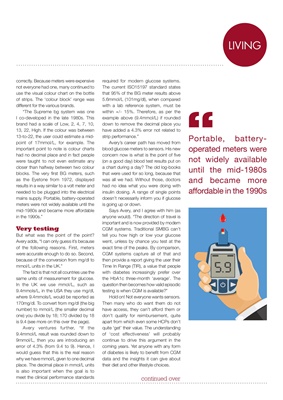
KITLIVING
continued over
correctly. Because meters were expensive
not everyone had one, many continued to
use the visual colour chart on the bottle
of strips. The 'colour block' range was
different for the various brands.
"The Supreme bg system was one
I co-developed in the late 1980s. This
brand had a scale of Low, 2, 4, 7, 10,
13, 22, High. If the colour was between
13-to-22, the user could estimate a midpoint
of 17mmol/L, for example. The
important point to note is colour charts
had no decimal place and in fact people
were taught to not even estimate any
closer than halfway between two colour
blocks. The very first BG meters, such
as the Eyetone from 1972, displayed
results in a way similar to a volt meter and
needed to be plugged into the electrical
mains supply. Portable, battery-operated
meters were not widely available until the
mid-1980s and became more affordable
in the 1990s."
Very testing
But what was the point of the point?
Avery adds, "I can only guess it's because
of the following reasons. First, meters
were accurate enough to do so. Second,
because of the conversion from mg/dl to
mmol/L units in the UK."
The fact is that not all countries use the
same units of measurement for glucose.
In the UK we use mmol/L, such as
9.4mmols/L, in the USA they use mg/dl,
where 9.4mmols/L would be reported as
170mg/dl. To convert from mg/dl (the big
number) to mmol/L (the smaller decimal
one) you divide by 18; 170 divided by 18
is 9.4 (see more on this over the page).
Avery ventures further, "If the
9.4mmol/L result was rounded down to
9mmol/L, then you are introducing an
error of 4.3% (from 9.4 to 9). Hence, I
would guess that this is the real reason
why we have mmol/L given to one decimal
place. The decimal place in mmol/L units
is also important when the goal is to
meet the clinical performance standards
required for modern glucose systems.
The current ISO15197 standard states
that 95% of the BG meter results above
5.6mmol/L (101mg/dl), when compared
with a lab reference system, must be
within +/- 15%. Therefore, as per the
example above (9.4mmol/L) if rounded
down to remove the decimal place you
have added a 4.3% error not related to
strip performance."
Avery's career path has moved from
blood glucose meters to sensors. His new
concern now is what is the point of five
(on a good day) blood test results put on
a chart during a day? The old log-books
that were used for so long, because that
was all we had. Without those, doctors
had no idea what you were doing with
insulin dosing. A range of single points
doesn't necessarily inform you if glucose
is going up or down.
Says Avery, and I agree with him (as
anyone would). "The direction of travel is
important and is now provided by modern
CGM systems. Traditional SMBG can't
tell you how high or low your glucose
went, unless by chance you test at the
exact time of the peaks. By comparison,
CGM systems capture all of that and
then provide a report giving the user their
Time In Range (TIR), a value that people
with diabetes increasingly prefer over
the HbA1c three-month 'average'. The
question then becomes how valid episodic
testing is when CGM is available?"
Hold on! Not everyone wants sensors.
Then many who do want them do not
have access, they can't afford them or
don't qualify for reimbursement, quite
apart from which even some HCPs don't
quite 'get' their value. The understanding
of 'cost effectiveness' will probably
continue to drive this argument in the
coming years. Yet anyone with any form
of diabetes is likely to benefit from CGM
data and the insights it can give about
their diet and other lifestyle choices. "Portable, batteryoperated meters were
not widely available
until the mid-1980s
and became more
affordable in the 1990s